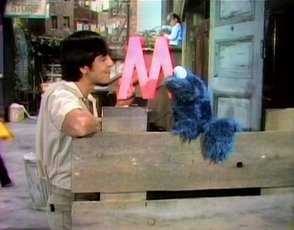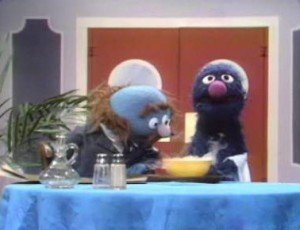Sesame Street Ep #276
From that point, we’re off and away to a bunch of quick segments, beginning with a cartoon about an unfortunate man who invites the letter “M” over for dinner and watches horrified as it eats literally everything in sight, and then we have another Herbert Birdsfoot scene. Although, as I explained before, he was originally brought on as Kermit’s rather unlikely replacement, he apparently continued to have a few sketches after Kermit came back this season, before being gradually phased out completely by 1974. This is a particularly cute one, in which he is introducing the letter–you guessed it!–“M,” when Grover comes along, repeatedly making a rather desperate-sounding but serendipitous “mmmm!” sound.
Rather than asking him why he’s doing this, the singleminded Herbert plows forwards with his lecture, letting Grover frustratedly make the noise before he himself lists a number of M words, a funny twist on the norm where Grover is the one driving him crazy. Finally, he smells peanut butter on Grover’s breath and realizes that the poor monster’s mouth must be glued together from a recent sticky meal. He helps pry his mouth open, and a much-relieved Grover thanks him profusely, only to then accidentally shut his mouth again a moment after Herbert leaves, once again helplessly stuck!
Then, Molly reappears, reiterating the letter M by introducing words such as her own name, “Molly,” the object around which her career revolves, “mailbox,” and then sighing over a guy she likes named “Melvin”. That Molly really is insatiable, huh? We then get a look at the Melvin of whom she speaks in a cartoon, in which we can ogle this moving man’s magnificent muscles. No wonder he has Molly all hot and bothered. Though the ’70s ‘stache has to go.
Thankfully, the following “M” sketch is much better, and not only because it’s a Luis and Cookie scene, although that would’ve been enough. And interestingly, Luis actually calls him “Cookie” as a name here, rather than “Monster,” as Gordon did in the past, or “Tiny,” as Cookie named himself in an earlier sketch with Ernie, indicating that by this point, they’d finally settled on that actually being his name. That doesn’t mean that cookies are now the only thing he’ll eat, however. Here, Luis holds up an “M,” and Cookie tells him that “M” reminds him of cookies. But Luis can’t imagine why. After all, “M” isn’t the first letter in “cookie”! And Cookie clarifies for him that “EVERYTHING make me think of cookies. Your legs make me think of cookies!…Your nose is a cookie to me!…The whole world is cookies!” At which point he’s worked himself into such a frenzy that he has to eat the “M” for good measure.
In addition to Frank Oz being absolutely hilarious here, it’s also another great example of Sesame Street‘s uncondescending approach to teaching children. The humor here is totally based in Cookie’s character, flipping our expectations from typical Sesame sketches by having the word discussed not be the “correct” one for the letter. They trust the kids to get that. Another thing of note here is that, after some earlier scenes in which Cookie speaks more correctly, Cookie’s grammar has continued to degrade here, putting him even more in line with the Cookie we know and love today. Which is, again, another example of Sesame Street trusting children to understand that Cookie is speaking the wrong way without feeling the constant need to reiterate it.
Then, we have 2 short cartoons, one about two sentient lines arguing but then eventually intersecting, the other a song about a cow singing about how “M is for Moo”. Afterwards, we’re in Bert and Ernie’s apartment for another really sweet scene between the two of them. It’s truly nice to see two of them in one episode, to help add a bit of balance to the ones where they’re at odds and remind us that at their heart, they’re best friends (and possibly more? wink wink).
Here, Bert walks in to discover a very sad Ernie. Genuinely concerned for his buddy, Bert asks what’s wrong, and Ernie says he just doesn’t think he’s special. He’s plain and ordinary. But Bert won’t stand for it. He tells him that of course he’s special. Everyone’s special! He tells him to feel his nose. “That’s an Ernie nose!” he says. He then tells him to feel his hair and his ears, showing him how all of these parts of him are unique. Nobody is just like him. And Ernie is so touched that he turns to the camera and tells the audience the same thing Bert told him. “Hey you, why are you looking like that? You’re a special person, too!” also telling them to feel their noses and their hair and to wiggle their fingers, etc. “Smile,” he says, “You’re a very special person too, like me.”
And I have to admit this bit actually cheered me up, too. We’re so used to Bert and Ernie sketches being comedic that to get one without a hint of humor that’s instead a gentle, kind scene of Bert helping Ernie feel better about himself, and then in turn Ernie helping us feel better about ourselves feels like a sweet little gift. If they did this sort of thing all the time, it would have been overly precious, yet because this didn’t happen often, it’s earned. And, again, the fact that Jim Henson and the other Sesame Street people realized that children don’t only need to learn letters and numbers but sometimes need to just be reassured that they’re special and loved–particularly lower-income and/or inner-city kids who might feel alienated, lonely, unappreciated, or let down by the people around them–shows just how perceptive and kind he and his team were. It’s this heart, along with the extremely intelligent humor, that makes the show stand out. It’s why it’s lasted so long.
This is followed by Susan and Rafael counting to 2 in English and Spanish, which is cool in a way, I guess, but like most of the Muppet-free, educational scenes, also rather stilted. In the future, they’ll go on to teach Spanish in far superior and infinitely more entertaining ways. Then, we have a repeat of “Doll House,” which I love so much that, of course, I watched it all the way through again. How could I not?
And then, we have another great scene, which seems to be the first time the show ever depicted Oscar walking down the street while still inside his trash can, his legs sticking out the bottom! David, Gordon, and Mr. Hooper look on incredulously and ask him what’s going on, and he tells them that he’s going down to the street to buy some “nice rotten apples” from the fruitstand but that he couldn’t bear to leave his treasures behind, such as his old vacuum cleaner bags and turtle head collection, so he knocked two holes in the bottom of his can so he could walk his home down the street with him! The fact that Oscar could actually move his can like this was one of the elements that really ignited Little Me’s imagination, particularly knowing how many rooms he had in there despite the fact that it’s so small on the outside. Oscar’s can really is a TARDIS and this confirms it. Since it clearly isn’t simply connected to a set of rooms in the sewer underneath its usual spot. No, his entire room and everything he owns is inside there! Though I’m not sure what’s more amazing: that or the fact that he then toodles out of sight singing “Chattanooga Choo-Choo”.
Then, after a brief cartoon in which a man illustrates “up” and “down” with signs, we come to the very first of one of the most classic series of Sesame Street sketches, namely the ones in which Grover was a generally hapless waiter at a restaurant, serving an impatient, round, blue Muppet guy with a mustache, later called Mr. Johnson. Interestingly, however, in this first classic installment, Mr. Johnson is actually the one causing the trouble for Grover, rather than the other way around! Mr. Johnson orders an alphabet soup, which Grover delivers promptly, but then this hard-to-please customer keeps calling him back again and again to complain when various letters are missing, demanding that Grover bring him each of them one by one. After giving him a J and then again going in back for an O, he yells to the offstage cook, “Charlie, we’ve got a weirdo!”
The last time features a fun little mistake on Jerry Nelson’s part that Frank Oz plays off of, ad-libbing beautifully. Mr. Johnson says that he’s missing a Y, before correcting himself that he meant a Z, and Grover responds, “See, you can’t always be right!” By the end, Grover has made sure that every single letter is finally in this crackpot’s soup, but he still isn’t happy. “The soup’s cold. Take it back and get me another bowl!” Grover faints in frustration. Which, is again, hilarious because the standard version of this sketch would have Mr. Johnson raising legitimate complaints against Grover, whose waitering usually leaves a great deal to be desired.
Next, we have a cartoon of an Indian guru counting from 1-20 in English and then Spanish (pretty incredible to see just how thoroughly they compensated for the underrepresentation of Spanish in this season!), and I can’t tell if the depiction of him with 4 Kali-like arms (thus to facilitate counting to 20 on his fingers) is a tad culturally insensitive or not (and it’s kind of weird that an Indian figure is teaching Spanish), though it was certainly well-meaning. Then, we have a scene where Susan is setting the table, and then Mr. Hooper, Bob, and a kid named Brian appear to help her, an off-screen narrator explaining that this is cooperation. Though what I’d like to know is why her husband, Fake Gordon, isn’t also!



